Evolution of the Beach–Dune Systems in Mediterranean Andalusia (Spain) Using Two Different Proxies
Abstract
:1. Introduction
2. Geographical Setting
3. Materials and Methods
3.1. GIS Project Creation
3.2. Change Rate Calculations
3.3. Statistical Analysis
- Accretion/accretion (AA): accretion classes were observed at the same transects for both shoreline and dune proxies.
- Accretion/erosion (AE): accretion was obtained for the dune proxy and erosion for the shoreline.
- Accretion/stability (AS): accretion was obtained for the dune proxy and stability for the shoreline.
- Erosion/erosion (EE): erosion classes were obtained for both shoreline and dune proxies.
- Erosion/accretion (EA): erosion was obtained for the dune proxy and accretion for the shoreline.
- Erosion/stability (ES): erosion was obtained for the dune proxy and stability for the shoreline.
- Stability/stability (SS): stability class was obtained for both dune and shoreline proxies.
- Stability/accretion (SA): stability was obtained for the dune proxy and accretion for the shoreline in the same transect.
- Stability/erosion (SE): stability was obtained for the dune proxy and erosion for the shoreline.
4. Results
5. Discussion
5.1. Spatial and Temporal Distribution of Evolution Classes
5.2. Beach–Dune System Behavior
- Dune erosion or disappearance may be linked to natural processes and/or human activities [60,72,73,116], and usually occurs very quickly. Foredune recovery requires months to years depending on sediment availability, the accommodation space, the colonization and growth of appropriate vegetation, and wind conditions [56,57,60,73,117,118,119,120].
5.3. Considerations for Coastal Management
- Erosion states represent systems that present different levels of degradation and need management measures;
- Mixed states represent systems with diverse levels of changeability or stability conditions, which can shift to an erosion state in the short/medium term. These systems need to be monitored to fully comprehend their present and future behaviors;
- Accretion states represent systems in a good state of health, and they do not need management measures in the short/medium term.
6. Conclusions
Author Contributions
Funding
Data Availability Statement
Acknowledgments
Conflicts of Interest
Appendix A
| Year | Error Components (m) | ||||||
|---|---|---|---|---|---|---|---|
| σd | σp | σr | σco | σwr | σtd | σT | |
| 1956 | 7.60 | 1.00 | 4.00 | 0.50 | 3.00 | 5.48 | 10.7 |
| 1977 | 2.10 | 0.50 | 3.30 | 0.50 | 3.00 | 5.48 | 7.4 |
| 2001 | 2.10 | 0.50 | 1.00 | 1.00 | 3.00 | 5.48 | 6.8 |
| 2010 | 1.90 | 0.50 | 0.50 | 0.00 | 3.00 | 5.48 | 6.6 |
| 2016 | 0.70 | 0.25 | 0.50 | 0.00 | 3.00 | 5.48 | 6.3 |
| 2019 | 0.70 | 0.25 | 0.20 | 0.00 | 3.00 | 5.48 | 6.3 |
| Year | Error Components (m) | ||||
|---|---|---|---|---|---|
| σd | σp | σr | σco | σT | |
| 1977 | 2.10 | 0.50 | 3.30 | 0.50 | 4.00 |
| 2001 | 2.10 | 0.50 | 1.00 | 1.00 | 2.60 |
| 2010 | 1.90 | 0.50 | 0.50 | 0.00 | 2.00 |
| 2016 | 0.70 | 0.25 | 0.50 | 0.00 | 0.90 |
| 2019 | 0.70 | 0.25 | 0.20 | 0.00 | 0.80 |
References
- Elliott, M.; Burdon, D.; Atkins, J.P.; Borja, A.; Cormier, R.; de Jonge, V.N.; Turner, R.K. “And DPSIR Begat DAPSI(W)R(M)!”—A Unifying Framework for Marine Environmental Management. Mar. Pollut. Bull. 2017, 118, 27–40. [Google Scholar] [CrossRef] [PubMed]
- Patricio, P.; Elliott, M.; Mazik, K.; Papadopoulou, K.-N.; Smith, J.S. DPSIR—Two Decades of Trying to Develop a Unifying Framework for Marine Environmental Management? Front. Mar. Sci. 2016, 3, 177. [Google Scholar] [CrossRef]
- Rizzo, A.; Anfuso, G. Coastal Dynamic and Evolution: Case Studies from Different Sites around the World. Water 2020, 12, 2829. [Google Scholar] [CrossRef]
- Cooper, J.A.G.; O’Connor, M.C.; McIvor, S. Coastal Defences versus Coastal Ecosystems: A Regional Appraisal. Mar. Policy 2020, 111, 102332. [Google Scholar] [CrossRef]
- Cooper, J.A.G.; Alonso, I. Natural and Anthropic Coasts: Challenges for Coastal Management in Spain. J. Coast. Res. SI 2006, 48, 1–7. [Google Scholar]
- Mentaschi, L.; Vousdoukas, M.I.; Pekel, J.-F.; Voukouvalas, E.; Feyen, L. Global Long-Term Observations of Coastal Erosion and Accretion. Sci. Rep. 2018, 8, 12876. [Google Scholar] [CrossRef] [PubMed]
- Vousdoukas, M.I.; Ranasinghe, R.; Mentaschi, L.; Plomaritis, T.A.; Athanasiou, P.; Luijendijk, A.; Feyen, L. Sandy Coastlines under Threat of Erosion. Nat. Clim. Change 2020, 10, 260–263. [Google Scholar] [CrossRef]
- Bird, E. Coastal Geomorphology: An Introduction; John Wiley & Sons: Hoboken, NJ, USA, 2011. [Google Scholar]
- Cooper, J.A.G.; Lemckert, C. Extreme Sea-Level Rise and Adaptation Options for Coastal Resort Cities: A Qualitative Assessment from the Gold Coast, Australia. Ocean Coast. Manag. 2012, 64, 1–14. [Google Scholar] [CrossRef]
- Phillips, M.R.; Jones, A.L. Erosion and Tourism Infrastructure in the Coastal Zone: Problems, Consequences and Management. Tour. Manag. 2006, 27, 517–524. [Google Scholar] [CrossRef]
- Sanò, M.; Jiménez, J.A.; Medina, R.; Stanica, A.; Sanchez-Arcilla, A.; Trumbic, I. The Role of Coastal Setbacks in the Context of Coastal Erosion and Climate Change. Ocean Coast. Manag. 2011, 54, 943–950. [Google Scholar] [CrossRef]
- Silva, R.; Martínez, M.L.; Hesp, P.A.; Catalan, P.; Osorio, A.F.; Martell, R.; Fossati, M.; Miot da Silva, G.; Mariño-Tapia, I.; Pereira, P.; et al. Present and Future Challenges of Coastal Erosion in Latin America. J. Coast. Res. 2014, 71, 1–16. [Google Scholar] [CrossRef]
- World Tourism Organization. International Tourism Highlights, 2023 Edition—The Impact of COVID-19 on Tourism (2020–2022); UNWTO: Madrid, Spain, 2023; ISBN 978-92-844-2497-9. [Google Scholar]
- Hanson, H.; Lindh, G. Coastal Erosion—An Escalating Environmental Threat. Ambio 1993, 22, 188–195. [Google Scholar]
- Bird, E.C.F. Coastline Changes. A Global Review; Wiley: Hoboken, NJ, USA, 1985; ISBN 0-471-90646-8. [Google Scholar]
- Aguilera, M.; Muñoz-Perez, J.J.; Contreras, A.; Contreras, A.; Lopez, P.; Jigena, B. Increase in the Erosion Rate Due to the Impact of Climate Change on Sea Level Rise: Victoria Beach, a Case Study. J. Mar. Sci. Eng. 2022, 10, 1912. [Google Scholar] [CrossRef]
- Disappearing Destinations: Climate Change and Future Challenges for Coastal Tourism; Jones, A.L.; Phillips, M.R. (Eds.) CABI: Wallingford, UK; Cambridge, MA, USA, 2011; ISBN 978-1-84593-548-1. [Google Scholar]
- Masselink, G.; Russell, P.; Rennie, A.; Brooks, S.; Spencer, T. Impacts of Climate Change on Coastal Geomorphology and Coastal Erosion Relevant to the Coastal and Marine Environment around the UK. MCCIP Sci. Rev. 2020, 2020, 158–189. [Google Scholar] [CrossRef]
- Anfuso, G.; Loureiro, C.; Taaouati, M.; Smyth, T.A.G.; Jackson, D.W.T. Spatial Variability of Beach Impact from Post-Tropical Cyclone Katia (2011) on Northern Ireland’s North Coast. Water 2020, 12, 1380. [Google Scholar] [CrossRef]
- Bacon, S.; Carter, D.J.T. Wave Climate Changes in the North Atlantic and North Sea. Int. J. Climatol. 1991, 11, 545–558. [Google Scholar] [CrossRef]
- Cid, A.; Menéndez, M.; Castanedo, S.; Abascal, A.J.; Méndez, F.J.; Medina, R. Long-Term Changes in the Frequency, Intensity and Duration of Extreme Storm Surge Events in Southern Europe. Clim. Dyn. 2016, 46, 1503–1516. [Google Scholar] [CrossRef]
- Dupuis, H.; Michel, D.; Sottolichio, A. Wave Climate Evolution in the Bay of Biscay over Two Decades. J. Mar. Syst. 2006, 63, 105–114. [Google Scholar] [CrossRef]
- Komar, P.D.; Allan, J.C. Increasing Hurricane-Generated Wave Heights along the U.S. East Coast and Their Climate Controls. J. Coast. Res. 2008, 242, 479–488. [Google Scholar] [CrossRef]
- Meyer-Arendt, K.J. Grand Isle, Louisiana: A Historic US Gulf Coast Resort Adapts to Hurricanes, Subsidence and Sea Level Rise. In Disappearing Destinations: Climate Change and Future Challenges for Coastal Tourism; Jones, A., Phillips, M., Eds.; CAB International: Wallingford, UK, 2011; pp. 203–217. ISBN 978-1-84593-548-1. [Google Scholar]
- Nguyen, T.T.X.; Bonetti, J.; Rogers, K.; Woodroffe, C.D. Indicator-Based Assessment of Climate-Change Impacts on Coasts: A Review of Concepts, Methodological Approaches and Vulnerability Indices. Ocean Coast. Manag. 2016, 123, 18–43. [Google Scholar] [CrossRef]
- Soomere, T. Extremes and Decadal Variations of the Northern Baltic Sea Wave Conditions. In Extreme Ocean Waves; Pelinovsky, E., Kharif, C., Eds.; Springer: Dordrecht, The Netherlands, 2008; pp. 139–157. ISBN 978-1-4020-8313-6. [Google Scholar]
- Wolf, J.; Woolf, D.; Bricheno, L. Impacts of Climate Change on Storms and Waves Relevant to the Coastal and Marine Environment around the UK. MCCIP Sci. Rev. 2020, 2020, 132–157. [Google Scholar] [CrossRef]
- Bruun, P. Worldwide Impact of Sea Level Rise on Shorelines. In Effects of Changes in Stratospheric Ozone and Global Climate. Sea Level Rise; Titus, J.G., Ed.; US Environmental Protection Agency: Washington, DC, USA, 1987; Volume 4, pp. 99–128. [Google Scholar]
- Boak, E.H.; Turner, I.L. Shoreline Definition and Detection: A Review. J. Coast. Res. 2005, 214, 688–703. [Google Scholar] [CrossRef]
- Pollard, J.A.; Spencer, T.; Brooks, S.M.; Christie, E.K.; Möller, I. Understanding Spatio-Temporal Barrier Dynamics through the Use of Multiple Shoreline Proxies. Geomorphology 2020, 354, 107058. [Google Scholar] [CrossRef]
- Díaz-Cuevas, P.; Prieto-Campos, A.; Fraile-Jurado, P.; Ojeda-Zújar, J.; Álvarez-Francoso, J.I. Shoreline “Proxies” Evaluation for Mid-Term Erosion Rates Calculation in Mesotidal and Microtidal Beaches (Andalusia, Spain). J. Coast. Res. 2020, 95, 1062–1066. [Google Scholar] [CrossRef]
- Moore, L.J.; Ruggiero, P.; List, J.H. Comparing Mean High Water and High Water Line Shorelines: Should Proxy-Datum Offsets Be Incorporated into Shoreline Change Analysis? J. Coast. Res. 2006, 224, 894–905. [Google Scholar] [CrossRef]
- Ruggiero, P.; Kaminsky, G.M.; Gelfenbaum, G. Linking Proxy-Based and Datum-Based Shorelines on a High-Energy Coastline: Implications for Shoreline Change Analyses. J. Coast. Res. 2003, 57–82. [Google Scholar]
- Durán, R.; Guillén, J.; Ruiz, A.; Jiménez, J.A.; Sagristà, E. Morphological Changes, Beach Inundation and Overwash Caused by an Extreme Storm on a Low-Lying Embayed Beach Bounded by a Dune System (NW Mediterranean). Geomorphology 2016, 274, 129–142. [Google Scholar] [CrossRef]
- Farris, A.S.; List, J.H. Shoreline Change as a Proxy for Subaerial Beach Volume Change. J. Coast. Res. 2007, 23, 740–748. [Google Scholar] [CrossRef]
- Cowell, P.J.; Stive, M.J.F.; Niedoroda, A.W.; De Vriend, H.J.; Swift, D.J.P.; Kaminsky, G.M.; Capobianco, M. The Coastal-Tract (Part 1): A Conceptual Approach to Aggregated Modeling of Low-Order Coastal Change. J. Coast. Res. 2003, 19, 812–827. [Google Scholar]
- Cenci, L.; Disperati, L.; Persichillo, M.G.; Oliveira, E.R.; Alves, F.L.; Phillips, M.R. Integrating Remote Sensing and GIS Techniques for Monitoring and Modeling Shoreline Evolution to Support Coastal Risk Management. GIScience Remote Sens. 2018, 55, 355–375. [Google Scholar] [CrossRef]
- Eamer, J.B.R.; Didier, D.; Kehler, D.; Manning, I.; Colville, D.; Manson, G.; Jagot, A.; Kostylev, V.E. Multi-Decadal Coastal Evolution of a North Atlantic Shel-Edge Vegetated Sand Island—Sable Island, Canada. Can. J. Earth Sci. 2022, 59, 812–825. [Google Scholar] [CrossRef]
- Saye, S.E.; van der Wal, D.; Pye, K.; Blott, S.J. Beach-Dune Morphological Relationships and Erosion/Accretion: An Investigation at Five Sites in England and Wales Using LIDAR Data. Geomorphology 2005, 72, 128–155. [Google Scholar] [CrossRef]
- Crowell, M.; Leatherman, S.P.; Buckley, M.K. Shoreline Change Analysis: Long Term versus Short Term Data. Shore Beach 1993, 61, 13–20. [Google Scholar]
- Leatherman, S.P. Shoreline Mapping: A Comparison of Techniques. Shore Beach 1983, 51, 28–33. [Google Scholar]
- Anthony, E.J. Beach Erosion. In Encyclopedia of Coastal Science; Finkl, C.W., Makowski, C., Eds.; Springer: Berlin/Heidelberg, Germany, 2017. [Google Scholar]
- Rangel-Buitrago, N.; Anfuso, G. Risk Assessment of Storms in Coastal Zones: Case Studies from Cartagena (Colombia) and Cadiz (Spain); Springer: Berlin/Heidelberg, Germany, 2015. [Google Scholar]
- Duarte, C.M.; Losada, I.J.; Hendriks, I.E.; Mazarrasa, I.; Marbà, N. The Role of Coastal Plant Communities for Climate Change Mitigation and Adaptation. Nat. Clim. Change 2013, 3, 961–968. [Google Scholar] [CrossRef]
- Fernández-Montblanc, T.; Duo, E.; Ciavola, P. Dune Reconstruction and Revegetation as a Potential Measure to Decrease Coastal Erosion and Flooding under Extreme Storm Conditions. Ocean Coast. Manag. 2020, 188, 105075. [Google Scholar] [CrossRef]
- Pagán, J.I.; López, I.; Bañón, L.; Aragonés, L. Consequences of Anthropic Actions in Cullera Bay (Spain). J. Mar. Sci. Eng. 2020, 8, 240. [Google Scholar] [CrossRef]
- Bochev-Van der Burgh, L.; Wijnberg, K.M.; Hulscher, S.J. Decadal-Scale Morphologic Variability of Managed Coastal Dunes. Coast. Eng. 2011, 58, 927–936. [Google Scholar] [CrossRef]
- European Environmental Agency. The Changing Faces of Europe’s Coastal Areas; Office for Official Publications of the European Union: Luxembourg, 2006. [Google Scholar]
- Nicholls, R.J.; Wong, P.P.; Burkett, V.; Codignotto, J.; Hay, J.; McLean, R.; Ragoonaden, S.; Woodroffe, C.D.; Abuodha, P.; Arblaster, J.; et al. Coastal Systems and Low-Lying Areas. In Climate Change 2007: Impacts, Adaptation and Vulnerability. Contribution of Working Group II to the Fourth Assessment Report of the Intergovernmental Panel on Climate Change; Parry, M.L., Canziani, O.F., Palutikof, J.P., van del Linden, P.J., Hanson, C.E., Eds.; Cambridge University Press: Cambridge, UK, 2007; pp. 315–356. [Google Scholar]
- European Union Directive 2011/92/EU of the European Parliament and of the Council of 13 December 2011 on the Assessment of the Effects of Certain Public and Private Projects on the Environment. Available online: https://eur-lex.europa.eu/legal-content/en/TXT/?uri=CELEX:32011L0092 (accessed on 16 May 2023).
- European Union Directive 2009/147/EC on the Conservation of Wild Birds. Available online: https://eur-lex.europa.eu/legal-content/EN/TXT/?uri=CELEX%3A32009L0147 (accessed on 16 May 2023).
- European Union Directive 2001/42/EC on the Assessment of the Effects of Certain Plans and Programmes on the Environment. Available online: https://eur-lex.europa.eu/legal-content/EN/ALL/?uri=CELEX%3A32001L0042 (accessed on 16 May 2023).
- European Union Directive 92/43/EEC of 21 May 1992 on the Conservation of Natural Habitats and of Wild Fauna and Flora. Available online: https://eur-lex.europa.eu/legal-content/EN/TXT/?uri=celex%3A31992L0043 (accessed on 16 May 2023).
- Hesp, P.A. Foredune Formation in Southeast Australia. In Coastal Geomorphology in Australia; Thom, B.G., Ed.; Academic Press: London, UK, 1984; pp. 69–97. ISBN 0-12-687880-3. [Google Scholar]
- Martínez, M.L.; Psuty, N.P.; Lubke, R.A. A Perspective on Coastal Dunes. In Coastal Dunes; Martínez, M.L., Psuty, N.P., Eds.; Springer: Berlin/Heidelberg, Germany, 2008; Volume 171, pp. 3–10. ISBN 978-3-540-74001-8. [Google Scholar]
- Nordstrom, K.F. Reestablishing Naturally Functioning Dunes on Developed Coasts. Environ. Manag. 2000, 25, 37–51. [Google Scholar] [CrossRef] [PubMed]
- Psuty, N.P. The Coastal Foredune: A Morphological Basis for Regional Coastal Dune Development. In Coastal Dunes; Martínez, M.L., Psuty, N.P., Eds.; Ecological Studies; Springer Berlin Heidelberg: Berlin, Heidelberg, 2008; Volume 171, pp. 11–27. ISBN 978-3-540-74001-8. [Google Scholar]
- Díez-Garretas, B.; Comino, O.; Asensi, A. Cambios Espacio-Temporales (1956–2013) de Ecosistemas Costeros En El Sur de La Península Ibérica (España). Mediterr. Bot. 2019, 40, 111–119. [Google Scholar] [CrossRef]
- Gómez Zotano, J. La Degradación de Dunas Litorales En Andalucía: Aproximación Geohistórica y Multiescalar. INGEO 2014. [CrossRef]
- Hesp, P. Foredunes and Blowouts: Initiation, Geomorphology and Dynamics. Geomorphology 2002, 48, 245–268. [Google Scholar] [CrossRef]
- Malvárez García, G.; Pollard, J.; Dominguez Rodriguez, R. Origins, Management, and Measurement of Stress on the Coast of Southern Spain. Coast. Manag. 2000, 28, 215–234. [Google Scholar] [CrossRef]
- Manno, G.; Anfuso, G.; Messina, E.; Williams, A.T.; Suffo, M.; Liguori, V. Decadal Evolution of Coastline Armouring along the Mediterranean Andalusia Littoral (South of Spain). Ocean Coast. Manag. 2016, 124, 84–99. [Google Scholar] [CrossRef]
- Pranzini, E. Airborne LIDAR Survey Applied to the Analysis of the Historical Evolution of the Arno River Delta (Italy). J. Coast. Res. 2007, SI-50, 400–409. [Google Scholar] [CrossRef]
- Prieto, A.; Ojeda, J.; Rodríguez, S.; Gracia, J.; Del Río, L. Procesos Erosivos (Tasas de Erosión) En Los Deltas Mediterráneos Andaluces: Herramientas de Análisis Espacial (DSAS) y Evolución Temporal (Servicios OGC). In Tecnologías de la Información Geográfica en el Contexto del Cambio Global. In Proceedings of the XV Congreso Nacional de Tecnologías de la Información Geográfica, Madrid, Spain, 19–21 September 2012. [Google Scholar]
- Davidson-Arnott, R.G.D.; Bauer, B.O. Controls on the Geomorphic Response of Beach-Dune Systems to Water Level Rise. J. Great Lakes Res. 2021, 47, 1594–1612. [Google Scholar] [CrossRef]
- Dunn, F.E.; Darby, S.E.; Nicholls, R.J.; Cohen, S.; Zarfl, C.; Fekete, B.M. Projections of Declining Fluvial Sediment Delivery to Major Deltas Worldwide in Response to Climate Change and Anthropogenic Stress. Environ. Res. Lett. 2019, 14, 084034. [Google Scholar] [CrossRef]
- Besset, M.; Anthony, E.J.; Bouchette, F. Multi-Decadal Variations in Delta Shorelines and Their Relationship to River Sediment Supply: An Assessment and Review. Earth-Sci. Rev. 2019, 193, 199–219. [Google Scholar] [CrossRef]
- Carter, R.W.G. Coastal Environments: An Introduction to the Physical, Ecological, and Cultural Systems of Coastlines; Academic Press: San Diego, CA, USA, 1988; ISBN 978-0-12-161855-1. [Google Scholar]
- Doody, J.P. Sand Dune Conservation, Management and Restoration; Coastal Research Library; Springer: Dordrecht, The Netherlands; New York, NY, USA, 2013; ISBN 978-94-007-4731-9. [Google Scholar]
- Molina, R.; Manno, G.; Lo Re, C.; Anfuso, G.; Ciraolo, G. A Methodological Approach to Determine Sound Response Modalities to Coastal Erosion Processes in Mediterranean Andalusia (Spain). JMSE 2020, 8, 154. [Google Scholar] [CrossRef]
- Gracia Prieto, F.J.; Sanjaume Saumell, E.; Hernández, L.; Hernández, A.I.; Flor, G.; Gómez-Serrano, M.Á. Dunas Marítimas y Continentales. In Bases Ecológicas Preliminares para la Conservación de los Tipos de Hábitat de Interés Comunitario en España; Ministerio de Medio Ambiente, y Medio Rural y Marino: Madrid, Spain, 2009; p. 106. ISBN 978-84-491-0911-9. [Google Scholar]
- Molina, R.; Manno, G.; Lo Re, C.; Anfuso, G. Dune Systems’ Characterization and Evolution in the Andalusia Mediterranean Coast (Spain). Water 2020, 12, 2094. [Google Scholar] [CrossRef]
- Sanjaume Saumell, E.; Gracia Prieto, F.J. Las Dunas en España; Sociedad Española de Geomorfología; Encuadernaciones Martínez: Puerto Real, Spain, 2011; ISBN 978-84-615-3780-8. [Google Scholar]
- DGPC. Actuaciones En La Costa 1988–1990; MOPV: Madrid, Spain, 1991; p. 307. [Google Scholar]
- Malvárez, G.C. The History of Shoreline Stabilization on the Spanish Costa Del Sol. In Pitfalls of Shoreline Stabilization; Cooper, J.A.G., Pilkey, O.H., Eds.; Springer Netherlands: Dordrecht, 2012; Volume 3, pp. 235–249. ISBN 978-94-007-4122-5. [Google Scholar]
- Malvárez García, G.; Pollard, J.; Rodríguez, R.D. The Planning and Practice of Coastal Zone Management in Southern Spain. J. Sustain. Tour. 2003, 11, 204–223. [Google Scholar] [CrossRef]
- Guisado, E.; Malvárez, G.C.; Navas, F. Morphodynamic Environments of the Costa Del Sol, Spain. J. Coast. Res. 2013, 65, 500–505. [Google Scholar] [CrossRef]
- Gómez-Zotano, J.; Alcántara-Manzanares, J.; Olmedo-Cobo, J.A.; Martínez-Ibarra, E. La Sistematización Del Clima Mediterráneo: Identificación, Clasificación y Caracterización Climática de Andalucía (España). Rev. De Geogr. Norte Gd. 2015, 161–180. [Google Scholar] [CrossRef]
- Chica Ruiz, J.A.; Barragán Muñoz, J.M. Estado y tendencia de los servicios de los ecosistemas litorales de Andalucía. 2011. [CrossRef]
- Molina, R.; Manno, G.; Lo Re, C.; Anfuso, G.; Ciraolo, G. Storm Energy Flux Characterization along the Mediterranean Coast of Andalusia (Spain). Water 2019, 11, 509. [Google Scholar] [CrossRef]
- Pita López, M.F. Capítulo Cuarto: El Clima De Andalucía. Geogr. De Andal. 2003, 137–173. [Google Scholar]
- Molina, R.; Anfuso, G.; Manno, G.; Gracia Prieto, F.J. The Mediterranean Coast of Andalusia (Spain): Medium-Term Evolution and Impacts of Coastal Structures. Sustainability 2019, 11, 3539. [Google Scholar] [CrossRef]
- Criado-Aldeanueva, F.; Del Río Vera, J.; García-Lafuente, J. Steric and Mass-Induced Mediterranean Sea Level Trends from 14 Years of Altimetry Data. Glob. Planet. Change 2008, 60, 563–575. [Google Scholar] [CrossRef]
- Tsimplis, M.; Spada, G.; Marcos, M.; Flemming, N. Multi-Decadal Sea Level Trends and Land Movements in the Mediterranean Sea with Estimates of Factors Perturbing Tide Gauge Data and Cumulative Uncertainties. Glob. Planet. Change 2011, 76, 63–76. [Google Scholar] [CrossRef]
- Puertos del Estado. Resumen de Parámetros Relacionados Con El Nivel Del Mar y La Marea Que Afectan a Las Condiciones de Diseño y Explotación Portuaria; Área Medio Físico; Puertos del Estado: Madrid, Spain, 2019. [Google Scholar]
- Pajak, M.J.; Leatherman, S. The high water line as shoreline indicator. J. Coast. Res. 2002, 18, 329–337. [Google Scholar]
- Virdis, S.G.P.; Oggiano, G.; Disperati, L. A Geomatics Approach to Multitemporal Shoreline Analysis in Western Mediterranean: The Case of Platamona-Maritza Beach (Northwest Sardinia, Italy). J. Coast. Res. 2012, 28, 624–640. [Google Scholar] [CrossRef]
- Manno, G.; Lo Re, C.; Ciraolo, G. Uncertainties in Shoreline Position Analysis: The Role of Run-up and Tide in a Gentle Slope Beach. Ocean Sci. 2017, 13, 661–671. [Google Scholar] [CrossRef]
- Nielsen, P.; Hanslow, D.J. Wave Runup Distributions on Natural Beaches. J. Coast. Res. 1991, 7, 1139–1152. [Google Scholar]
- Puertos del Estado Puertos Del Estado. Available online: https://www.puertos.es/es-es/oceanografia/Paginas/portus.aspx (accessed on 23 February 2023).
- Himmelstoss, E.A.; Henderson, R.E.; Kratzmann, M.G.; Farris, A.S. Digital Shoreline Analysis System (DSAS) Version 5.0 User Guide; U.S. Geological Survey: Reston, VA, UAS, 2018. [Google Scholar]
- Anfuso, G.; Bowman, D.; Danese, C.; Pranzini, E. Transect Based Analysis versus Area Based Analysis to Quantify Shoreline Displacement: Spatial Resolution Issues. Environ. Monit. Assess. 2016, 188, 568. [Google Scholar] [CrossRef] [PubMed]
- Del Río, J.L.; Malvárez, G.; Navas, F. Aportes sedimentarios fluviales en el sistema litoral y su importancia para la gestión de costas: El caso de la Ensenada de Marbella. Geotemas 2015, 15, 165–168. [Google Scholar]
- Senciales González, J.M.; Malvárez, G. La Desembocadura Del Río Vélez (Provincia de Málaga, España). Evolución Reciente de Un Delta de Comportamiento Mediterráneo. Rev. C. G. 2003, 17, 47–61. [Google Scholar]
- Viciana Martínez-Lage, A. La costa de Almería: Desarrollo socio-económico y degradación físico-ambiental (1957–2007). Parallelo 37 2007, 19, 149–183. [Google Scholar]
- Gómez-Pina, G.; Muñoz-Pérez, J.J.; Ramírez, J.L.; Ley, C. Sand Dune Management Problems and Techniques, Spain. J. Coast. Res. 2002, 36, 325–332. [Google Scholar] [CrossRef]
- Jiménez, J.A.; Sánchez-Arcilla, A. Medium-Term Coastal Response at the Ebro Delta, Spain. Mar. Geol. 1993, 114, 105–118. [Google Scholar] [CrossRef]
- Syvitski, J.P.M.; Vörösmarty, C.J.; Kettner, A.J.; Green, P. Impact of Humans on the Flux of Terrestrial Sediment to the Global Coastal Ocean. Science 2005, 308, 376. [Google Scholar] [CrossRef] [PubMed]
- Kim, J.; Choi, J.; Choi, C.; Hwang, C. Forecasting the Potential Effects of Climatic and Land-Use Changes on Shoreline Variation in Relation to Watershed Sediment Supply and Transport. J. Coast. Res. 2017, 33, 874–888. [Google Scholar] [CrossRef]
- Frihy, O.E.; Komar, P.D. Patterns of Beach-Sand Sorting and Shoreline Erosion on the Nile Delta. J. Sediment. Petrol. 1991, 61, 544–550. [Google Scholar]
- Flor-Blanco, G.; Alcántara-Carrió, J.; Jackson, D.W.T.; Flor, G.; Flores-Soriano, C. Coastal Erosion in NW Spain: Recent Patterns under Extreme Storm Wave Events. Geomorphology 2021, 387, 107767. [Google Scholar] [CrossRef]
- Griggs, C.B. The Impacts of Coastal Armoring. Shore Beach 2005, 73, 13–22. [Google Scholar]
- Dugan, J.; Airoldi, L.; Chapman, M.; Walker, S.; Schlacher, T.; Wolanski, E.; McLusky, D. Estuarine and Coastal Structures: Environmental Effects, a Focus on Shore and Nearshore Structures. In Treatise on Estuarine and Coastal Science; Wolanski, E., McLusky, D., Eds.; Academic Press: Cambridge, MA, USA, 2011; Volume 8, pp. 17–41. [Google Scholar]
- Pranzini, E.; Anfuso, G.; Cinelli, I.; Piccardi, M.; Vitale, G. Shore Protection Structures Increase and Evolution on the Northern Tuscany Coast (Italy): Influence of Tourism Industry. Water 2018, 10, 1647. [Google Scholar] [CrossRef]
- Anfuso, G.; Martínez-del-Pozo, J.Á.; Rangel-Buitrago, N. Morphological Cells in the Ragusa Littoral (Sicily, Italy). J. Coast. Conserv. 2013, 17, 369–377. [Google Scholar] [CrossRef]
- Bray, M.J.; Carter, D.J.; Hooke, J.M. Littoral Cell Definition and Budgets for Central Southern England. J. Coast. Res. 1995, 11, 381–400. [Google Scholar]
- Wiggins, M.; Scott, T.; Masselink, G.; Russell, P.; Valiente, N.G. Regionally-Coherent Embayment Rotation: Behavioural Response to Bi-Directional Waves and Atmospheric Forcing. J. Mar. Sci. Eng. 2019, 7, 116. [Google Scholar] [CrossRef]
- Pranzini, E.; Williams, A.T. The Equilibrium Concept, Or…(Mis)Concept in Beaches. Geosciences 2021, 11, 59. [Google Scholar] [CrossRef]
- Bardají, T.; Zazo, C.; Lario, C.; Goy, J.L.; Cabero, A.; Dabrio, A.; Silva, P.G. Las Dunas Costeras del Presente y Último Interglaciar en Málaga, Almería y Murcia; Sociedad Española de Geomorfología: Madrid, Spain, 2011; pp. 331–357. [Google Scholar]
- Bayo Martinez, A. Tratamiento Técnico del Borde Litoral Almeriense. In Proceedings of the Actas de las Jornadas Sobre el Litoral de Almería: Caracterización, Ordenación y Gestión de un Espacio Geográfico Celebradas en Almería, Almería, Spain, 20–24 May 1997; pp. 207–232. [Google Scholar]
- Castaño Camero, N.; Arteaga Cardineau, C.; Gómez Zotano, J. Erosión en la playa del “Saladillo—Matas Verdes” (Estepona, Málaga): Situación actual y causas potenciales. IX J. Geomorfol. Litoral 2017, 17, 59–62. [Google Scholar]
- MITECO Actuaciones En La Costa. Available online: https://www.miteco.gob.es/es/costas/temas/proteccion-costa/actuaciones-proteccion-costa.html (accessed on 20 April 2023).
- Junta de Andalucía Law 2/1989, of July 18th, Which Approves the Inventory of Protected Natural Spaces in Andalusia and Establishes Additional Measures for Their Protection. Available online: https://www.boe.es/eli/es-an/l/1989/07/18/2/con (accessed on 16 May 2023).
- Junta de Andalucía Decree no. 314/1987 of the Ministry of the Presidency, of 23 December. Declaration of natural park to Cabo de Gata-Nijar. Available online: https://ws040.juntadeandalucia.es/sedeboja/web/textos-consolidados/resumen-ficha?p_p_id=resumenrecursolegal_WAR_sedebojatextoconsolidadoportlet&p_p_lifecycle=0&_resumenrecursolegal_WAR_sedebojatextoconsolidadoportlet_recursoLegalAbstractoId=15252 (accessed on 16 May 2023).
- Junta de Andalucía Acuerdo de Consejería de Medio Ambiente, de 13 Marzo 2012. Aprueba Los Planes de Recuperación y Conservación de Determinadas Especies Silvestres y Hábitats Protegidos. 2012. Available online: https://www.juntadeandalucia.es/boja/2012/60/7 (accessed on 16 May 2023).
- Ley Vega de Seoane, C.; Gallego Fernández, J.B.; Vidal Pascual, C.; Direccion General de Costas. Manual de Restauración de Dunas Costeras; Direccion General de Costas: Madrid, Spain, 2009; ISBN 978-84-8320-409-2. [Google Scholar]
- Anfuso, G.; Dominguez, L.; Gracia, F. Short and Medium-Term Evolution of a Coastal Sector in Cadiz, SW Spain. Catena 2007, 70, 229–242. [Google Scholar] [CrossRef]
- Castelle, B.; Bujan, S.; Ferreira, S.; Dodet, G. Foredune Morphological Changes and Beach Recovery from the Extreme 2013/2014 Winter at a High-Energy Sandy Coast. Mar. Geol. 2017, 385, 41–55. [Google Scholar] [CrossRef]
- Jackson, D.W.T.; Costas, S.; González-Villanueva, R.; Cooper, J.A.G. A Global ‘Greening’ of Coastal Dunes: An Integrated Consequence of Climate Change? Glob. Planet. Change 2019, 182, 103026. [Google Scholar] [CrossRef]
- Martínez, M.L.; Psuty, N.P. Coastal Dunes: Ecology and Conservation; Springer: Berlin/Heidelberg, Germany, 2004; ISBN 978-3-540-74002-5. [Google Scholar]
- Malvárez, G.; Navas, F.; Guisado-Pintado, E.; Jackson, D.W.T. Morphodynamic Interactions of Continental Shelf, Beach and Dunes: The Cabopino Dune System in Southern Mediterranean Spain. Earth Surf. Process. Landf. 2019, 44, 1647–1658. [Google Scholar] [CrossRef]
- Pranzini, E.; Wetzel, L.; Williams, A. Aspects of Coastal Erosion and Protection in Europe. J. Coast. Conserv. 2015, 19, 445–459. [Google Scholar] [CrossRef]
- Martínez, M.L.; Gallego Fernández, J.B.; Hesp, P.A. Restoration of Coastal Dunes; Springer Series on Environmental Management; Springer-Verlag: Berlin/Heidelberg, Germany, 2013. [Google Scholar]
- Nordstrom, K.F. Beach and Dune Restoration; Cambridge University Press: Cambridge, UK, 2021. [Google Scholar]
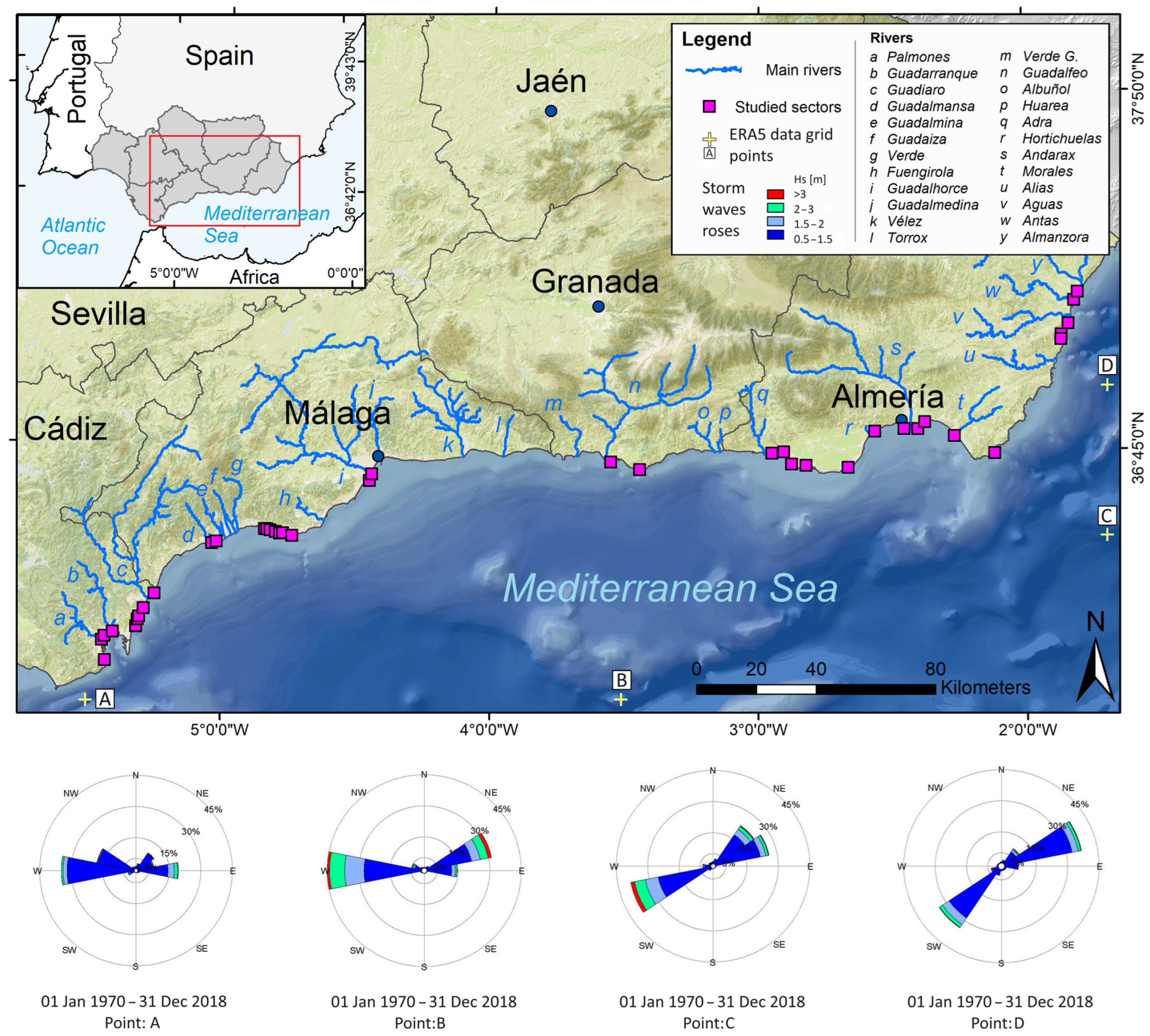
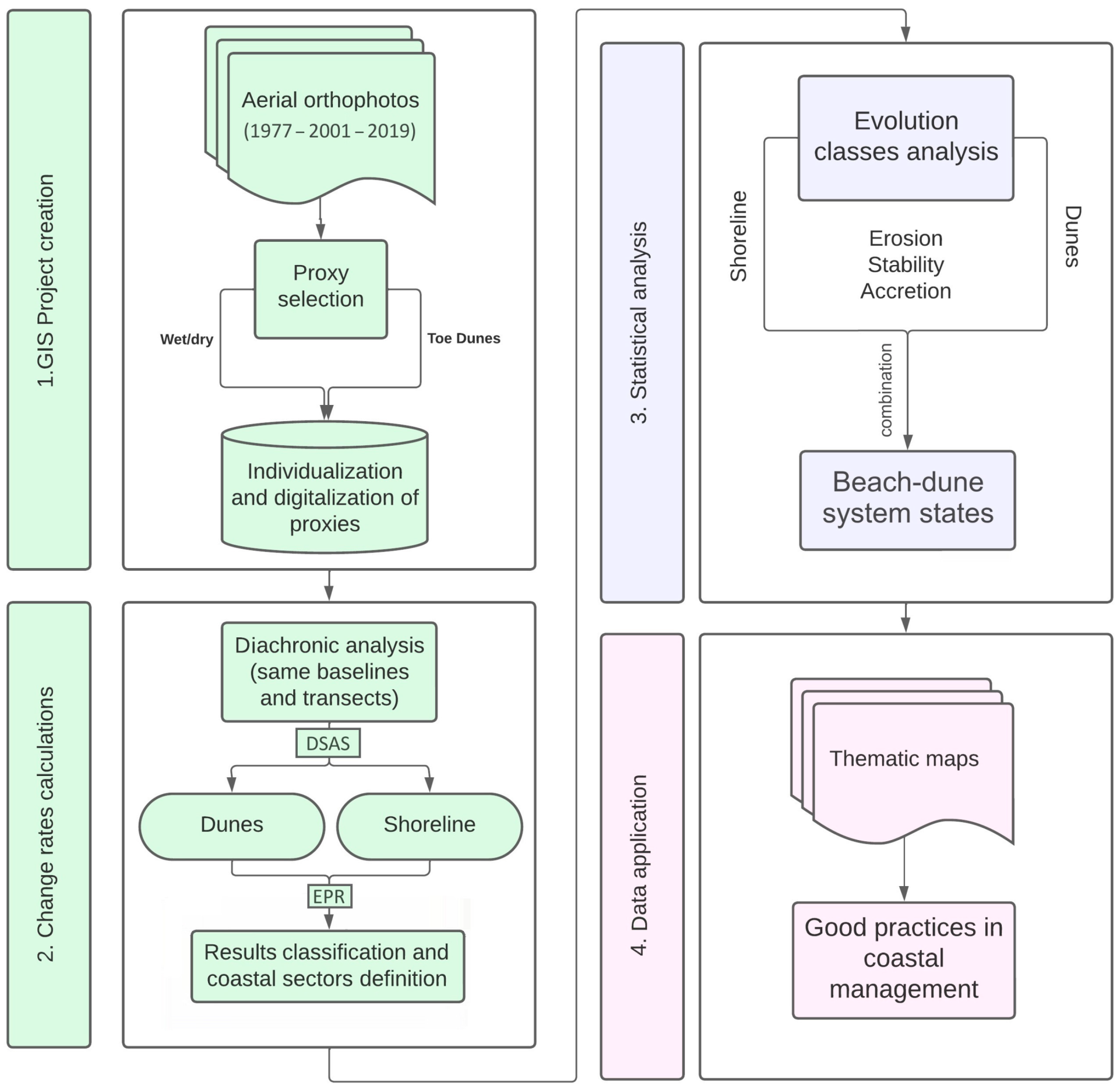
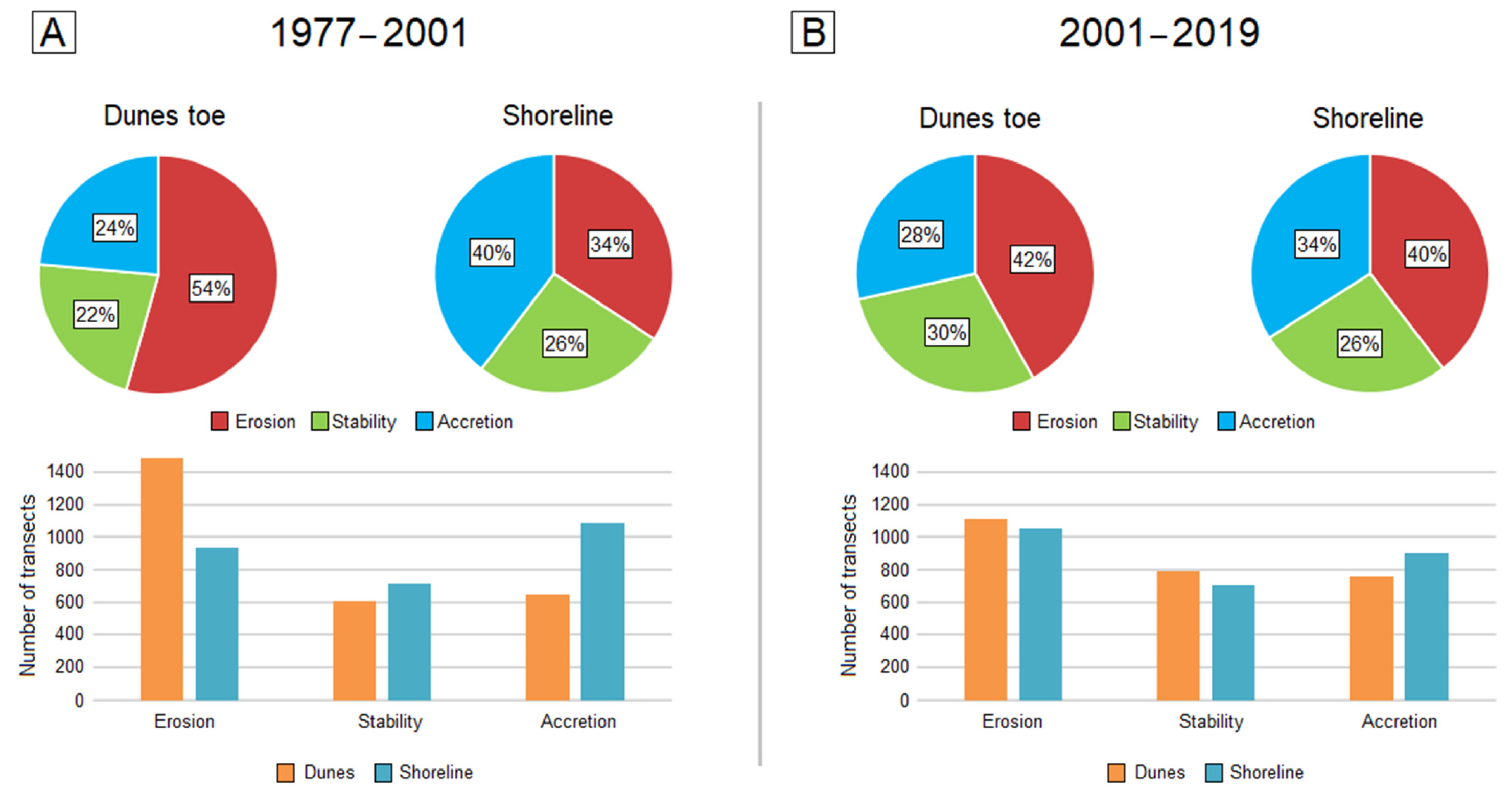
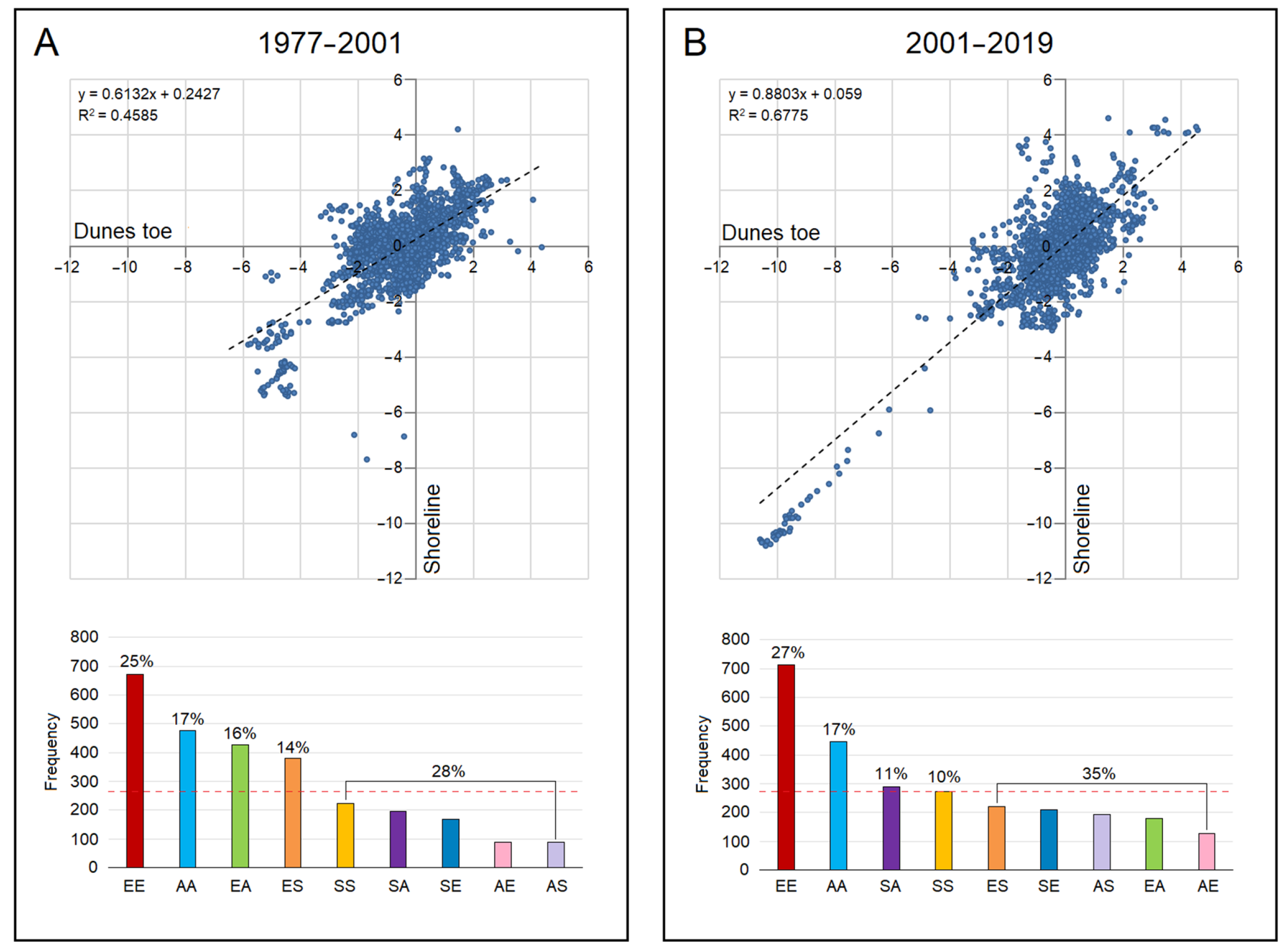
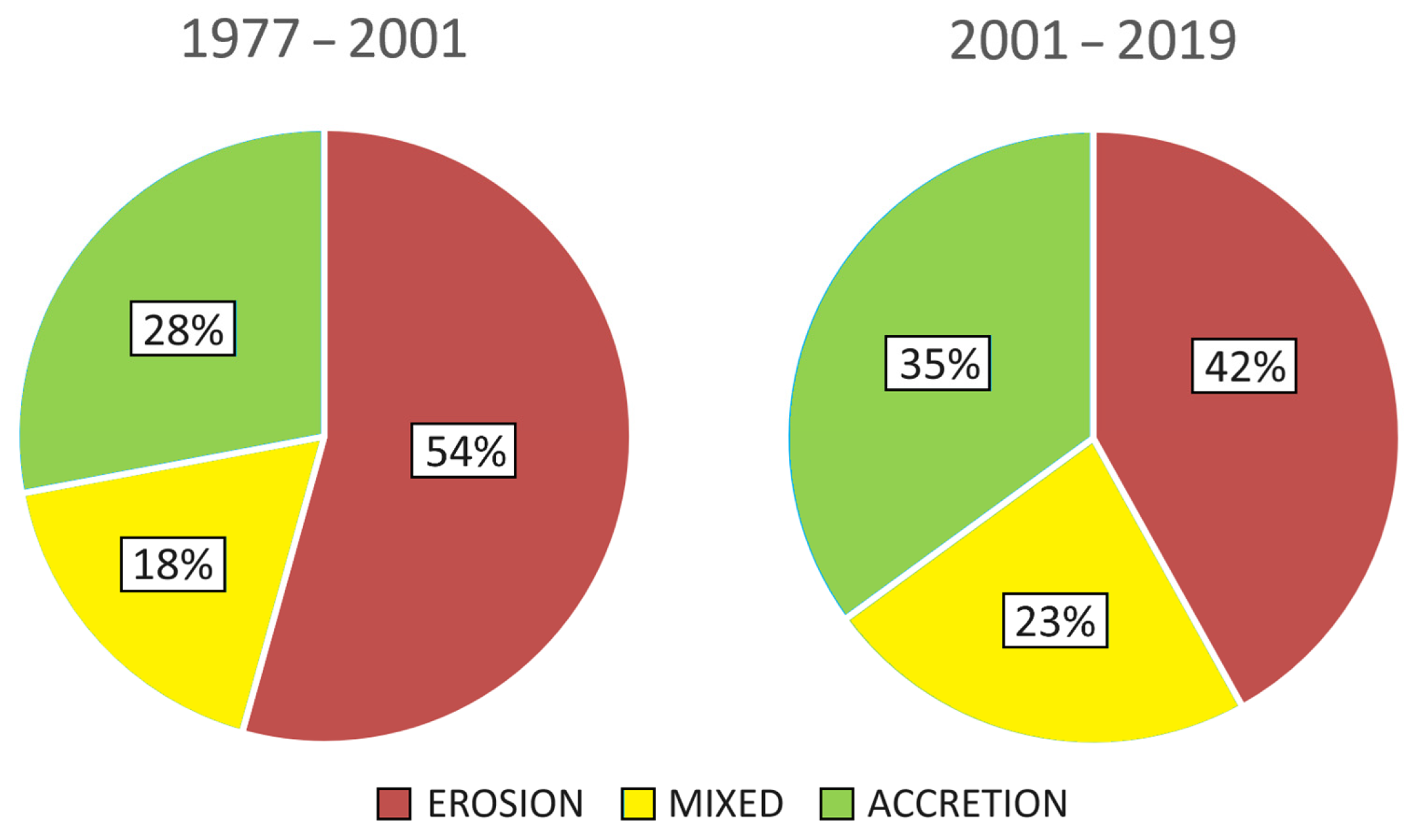
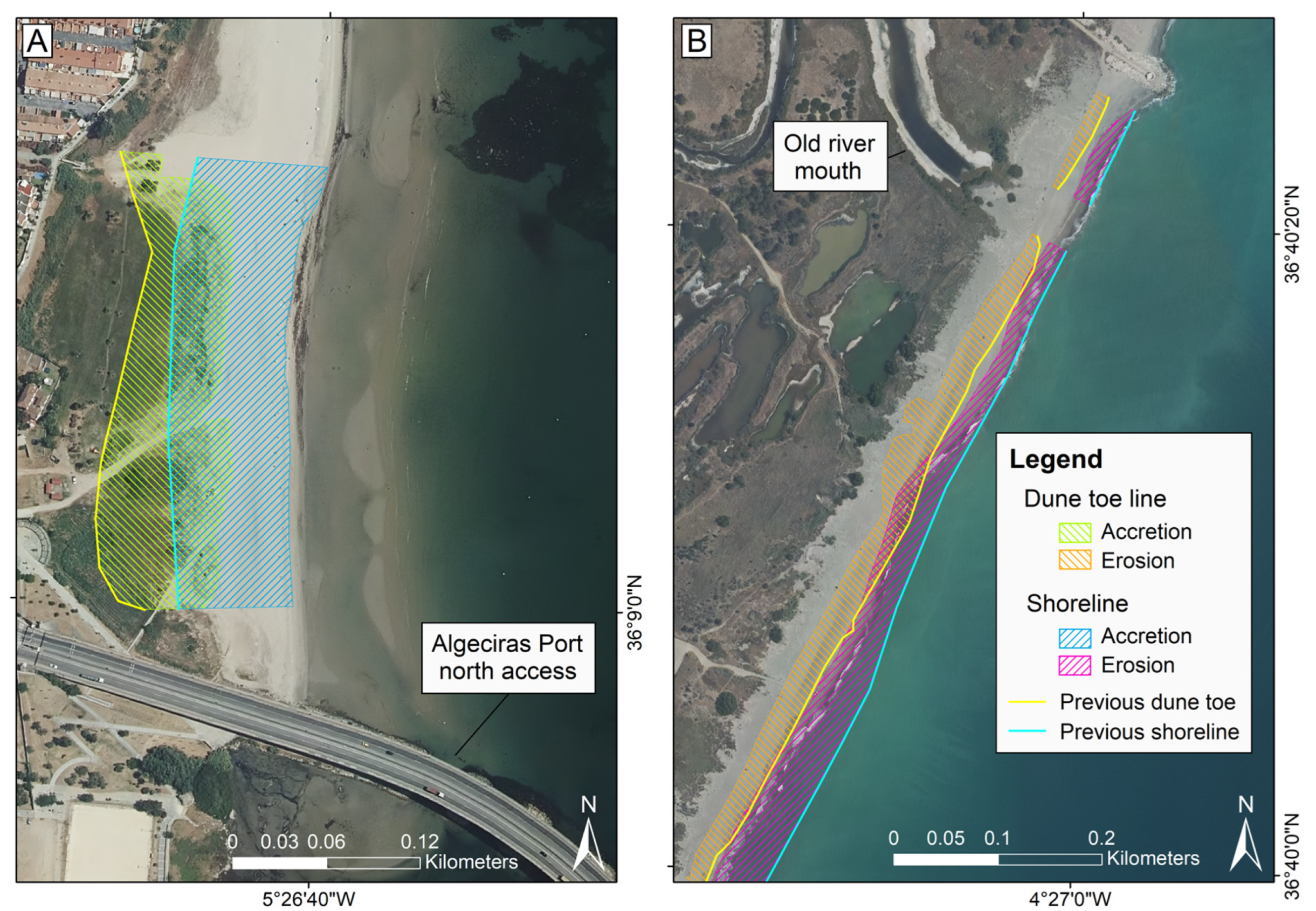
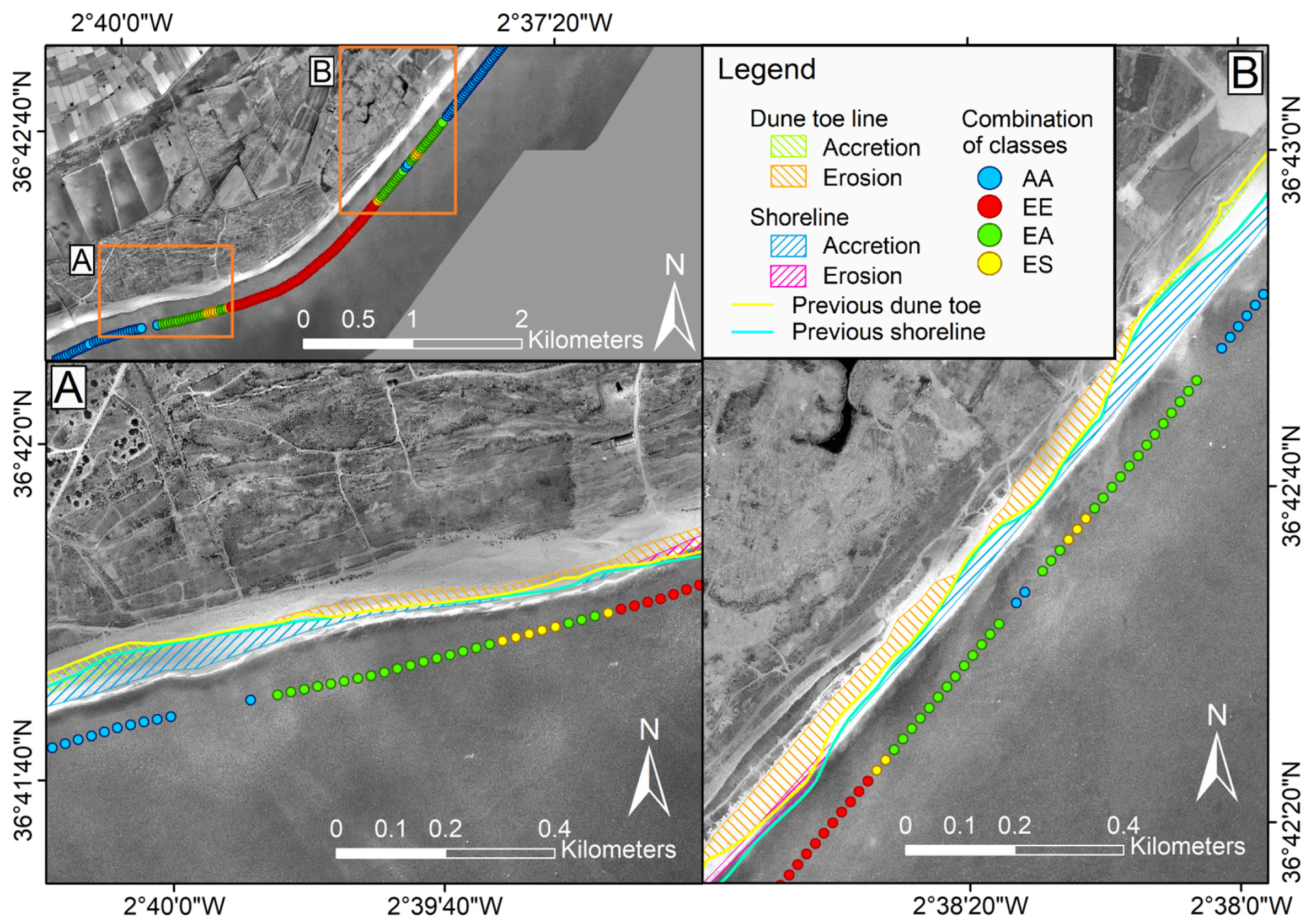
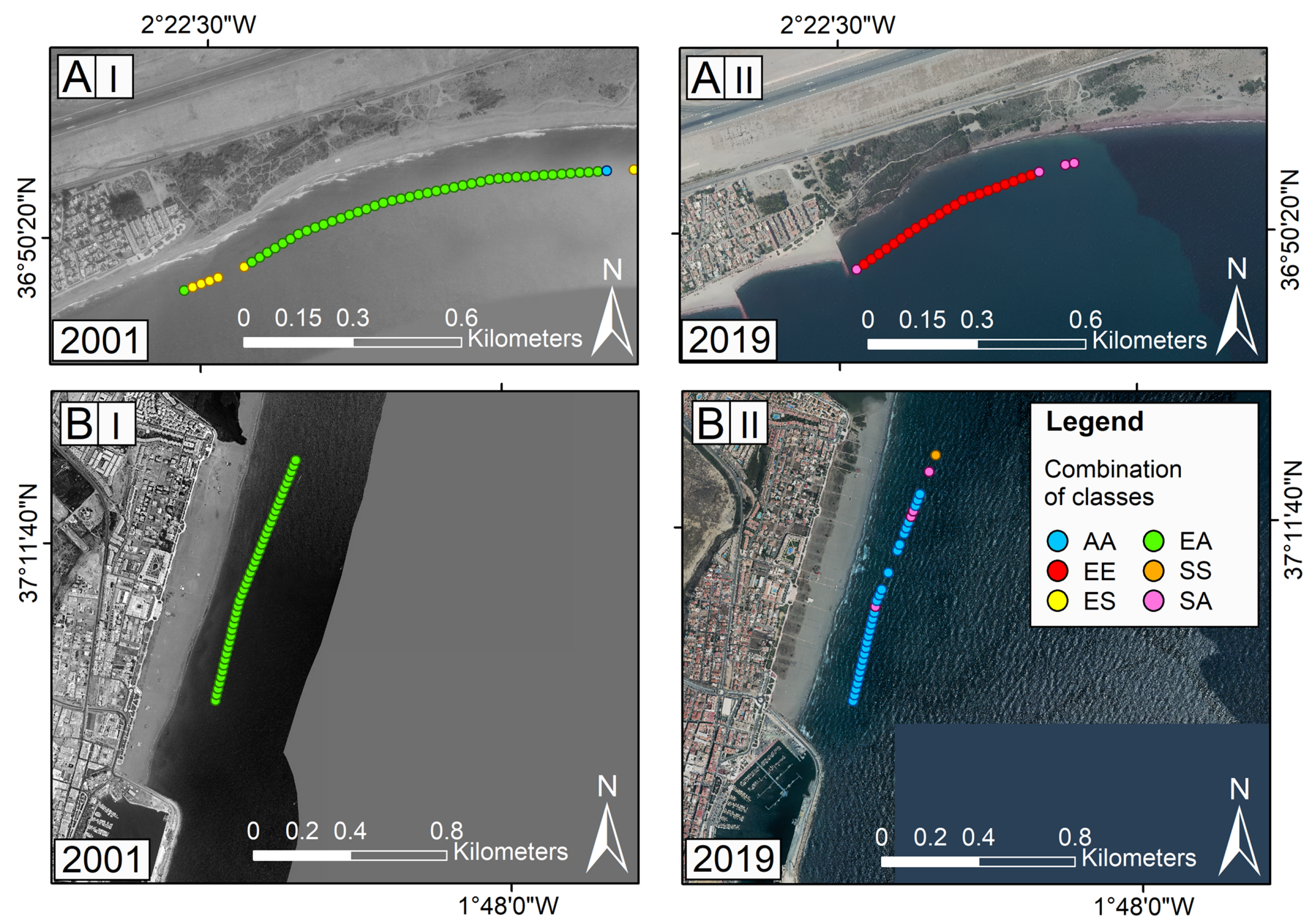
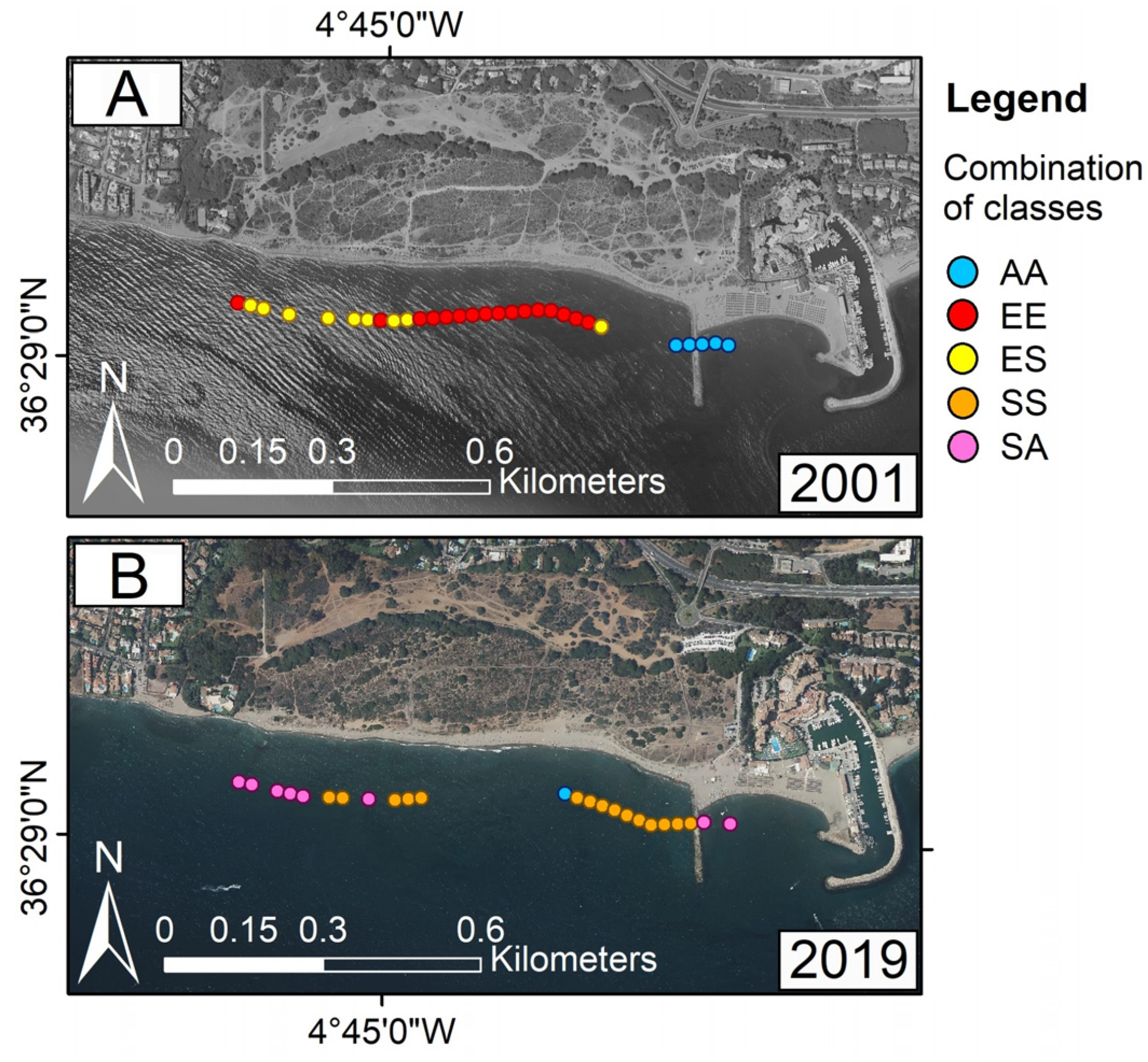
| Class | m/Year |
|---|---|
| Accretion | >+0.2 |
| Stability | >−0.2; ≤+0.2 |
| Erosion | <−0.2 |
| Combinations of Classes | Brief Description |
|---|---|
| EE | Dominant in both periods, it occurred in both natural and urbanized areas (35% in both periods), in areas down-drift of coastal structures and at river/delta mouths (24% in 1977–2001 and 30% in 2001–2019) and natural promontories (41% in 1977–2001 and not observed in 2001–2019), and down-drift of anthropic structures as groins and ports (29% in 2001–2019 and not observed in 1977–2001). |
| AA | Widespread in both periods, this class was observed in natural areas that act as sinks for sediment eroded from adjacent areas (56% in 1997–2001 and 45% in 2001–2019), in areas up-drift of anthropic structures such as groins and ports (15% in 1977–2001 and 30% in 2001–2019), in artificially altered areas (19% in 1977–2001 and 20% in 2001–2019). |
| EA | Most common during the 1977–2001 period, this pairing was mostly observed to be interspersed with other combinations of classes such as ES and AA at human altered areas (29%), in areas up- and down-drift of anthropic structures (27%), river mouths (23%), rocks, and natural promontories (18%) and at pocket beaches (3%). This combination of classes is especially common in two large (mostly) natural areas in Almeria province (see Discussion). |
| ES | Relevant during the 1977–2001 period, this was mostly observed to be interspersed with other combinations of classes as EA and EE in the areas down-drift of river mouths (50%), anthropic structures (12%), and natural promontories (5%) and, in less frequently, up-drift of them (12%), at pocket beaches (12%) and at human-altered areas as described in the AA case (10%). This combination of classes is especially prevalent in two large (mostly) natural areas in Almeria province (see Discussion). |
| SS | Relevant during the 2001–2019 period, this pairing was mostly observed to be interspersed with other combinations of classes such as AA and SA in natural protected areas (52%), and with EE in areas down-drift of river mouths (28%) and anthropic structures (16%). |
| SA | Important during the 2001–2019 period, this situation was mostly observed to be interspersed with other combinations of classes such as AA and SS in natural protected areas (51%), down-drift of river mouths and structures (20%) and, less frequently, up-drift of them (17%). |
| State of the System | Combination of Evolution Classes | Conditions of the Beach–Dune System |
|---|---|---|
| Erosion | EE | Severe degradation. Both proxies present erosion, indicating a severe deterioration of the beach–dune system. |
| ES | Degradation. This is a signal of deterioration of the system as dunes experience erosion and the beach is stable. | |
| EA | Moderate degradation. This is a signal of moderate deterioration of the system as dunes present erosion and the beach is accreting. | |
| Mixed | SS | Stable. Both proxies present stability indicating no significative changes in the beach–dune system. |
| SE | Very variable. Changes may be expected as the dunes, that are not already receiving sediment, will probably register a future loss of sediment if beach erosion continues. | |
| AE | Variable. Minor changes are expected in the system as the dunes may stop growing or register a loss of sediment if beach erosion continues. | |
| Accretion | AA | Good healthy conditions. The system presents very good health as both proxies indicate accretion. |
| AS | Healthy. The system is in healthy condition as dunes are accreting and shoreline registers stability. | |
| SA | Moderately healthy. The system indicates moderately healthy conditions as dunes register stability and the shoreline presents accretion. |
Disclaimer/Publisher’s Note: The statements, opinions and data contained in all publications are solely those of the individual author(s) and contributor(s) and not of MDPI and/or the editor(s). MDPI and/or the editor(s) disclaim responsibility for any injury to people or property resulting from any ideas, methods, instructions or products referred to in the content. |
© 2024 by the authors. Licensee MDPI, Basel, Switzerland. This article is an open access article distributed under the terms and conditions of the Creative Commons Attribution (CC BY) license (https://creativecommons.org/licenses/by/4.0/).
Share and Cite
Molina, R.; Anfuso, G.; González-Aguilar, B.; Manno, G.; Cooper, J.A.G. Evolution of the Beach–Dune Systems in Mediterranean Andalusia (Spain) Using Two Different Proxies. Land 2024, 13, 1185. https://doi.org/10.3390/land13081185
Molina R, Anfuso G, González-Aguilar B, Manno G, Cooper JAG. Evolution of the Beach–Dune Systems in Mediterranean Andalusia (Spain) Using Two Different Proxies. Land. 2024; 13(8):1185. https://doi.org/10.3390/land13081185
Chicago/Turabian StyleMolina, Rosa, Giorgio Anfuso, Belén González-Aguilar, Giorgio Manno, and J. Andrew G. Cooper. 2024. "Evolution of the Beach–Dune Systems in Mediterranean Andalusia (Spain) Using Two Different Proxies" Land 13, no. 8: 1185. https://doi.org/10.3390/land13081185
APA StyleMolina, R., Anfuso, G., González-Aguilar, B., Manno, G., & Cooper, J. A. G. (2024). Evolution of the Beach–Dune Systems in Mediterranean Andalusia (Spain) Using Two Different Proxies. Land, 13(8), 1185. https://doi.org/10.3390/land13081185













